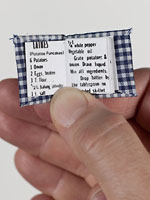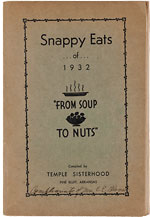Recipe for Success
Over the past eight years, one librarian has created the largest collection of Jewish cookbooks in the country. By Karen EdwardsKaren Edwards has been a freelance writer for Woman’s Day, Health, Eating Well, Entrepreneur, Antique Week, Early American Life, and Fine Books & Collections.
“Where are your Jewish cookbooks?”
The question wasn’t unusual for Roberta Saltzman, a librarian with the New York Public Library system, when it was asked by a patron eight years ago—but it did make her stop and think.
“At the time, I didn’t know if we had any Jewish cookbooks,” said Saltzman. There weren’t many, and after finding only a few on the library’s shelves, Saltzman jumped into action. She logged onto an online auction site to see what kinds of Jewish cookbooks were still available in the marketplace, and she learned there were plenty—so many, in fact, that over the past eight years, Saltzman has bid on and won more than 700 Jewish cookbooks, including some historically and culturally important books.
Saltzman has donated all of them to the Dorot Jewish Division of the NYPL, where she is now the assistant chief librarian. As a result of her discerning eye and tenacious bidding, the Dorot Division now has what’s believed to be the largest assembled collection of Jewish cookbooks in the United States and quite possibly the world.
Most of the cookbooks Saltzman has collected are community or charity cookbooks, gathered from nearly every state. Many of these cookbooks were compiled by local and national organizations, including the Midbar Kodesh Temple Sisterhood (Dining at our Sisters’ Table) and The Ladies Auxiliary of Yeshiva Masoras Avos (Dining in: from Simple to Splendid—Enjoyed in Your Home).
“They’re quaint, often funny books that provide a social history, a little insight into life at the time,” said Saltzman.
Because these books were paperbound and of narrow interest, many community cookbooks didn’t survive, and that’s a shame, said Jan Longone, curator of American Culinary History at the Clements Library in Ann Arbor, Michigan. Longone has been an antiquarian cookbook collector for 35 years and recently assembled an exhibit, “The Old Girl Network: Charity Cookbooks and the Empowerment of Women,” for the Clements Library. The charity cookbooks in Saltzman’s collection “serve to document the assimilation of the Jewish culture to American ways and the spread of the old culture to America,” said Longone.
Still, most of the Jewish cookbooks in the Dorot division are not Kosher, which doesn’t surprise Longone.
“The earliest Jewish charities were very well assimilated and German Jews were in no way Kosher,” she explained. Besides, there was a time in American history when Jewish cooks didn’t feel comfortable using the word Jewish. “That’s why Passover dishes are sometimes called Easter dishes,” said Longone.
As important as the charity cookbooks in the collection are (they’re considered ephemera, so most libraries don’t collect them, said Longone), Saltzman has also been able to acquire rare and unusual cookbooks. For example, she found an original 1846 edition of the first published Jewish cookbook, The Jewish Manual, by Judith Cohen Montefiori, as well as a cookbook from the early years of the Israel state and a fundraising cookbook produced in Berlin by the Jüdischer Frauenbund, an early German feminist organization. What’s remarkable about that cookbook is the publishing date—1935—which means Adolph Hitler was in power at the time. The collection also represents thirteen different languages, ranging from German and Hebrew, which might be expected, to Turkish and Portuguese.
The cookbooks have cost Saltzman anywhere from $5 to $80 each. She’s still collecting and donating her foody finds to the library, and she still acquires most of the books online instead of in bookstores or at book fairs. Saltzman doesn’t confine her collections to the antiquarian, however. She buys new Jewish cookbooks, if they seem to fit into the collection. Additional books have also been added through library patrons who learned about the Dorot Division’s collection and offered to donate their own Jewish cookbooks.
Not all of the cookbooks Saltzman has collected are in the best condition, she said, but she’s more concerned with preserving a one-of-a-kind cookbook than collecting quality bindings. Longone agreed. “If it’s a charity cookbook I’ve never seen before, I buy it and hope I can upgrade it eventually,” she said. If that never happens, at least a copy has been preserved.
Rebecca Federman, a NYPL librarian who has worked extensively with the library’s culinary and menu collections, said the library, which has its own preservation and conservation lab, tries to minimize damage to the cookbooks in poor condition by placing them in protective enclosures or making sure they’re used under supervision in the reading room.
What’s important is that the books are used and read. “We’ve had everyone from food historians to everyday cooks come in and use the books,” said Saltzman.
“The Jewish cookbook collection adds a depth and richness to the overall cookery collection,” said Federman, who blogs about cookbooks for the NYPL. “The Jewish community cookbooks are particularly fascinating glimpses of Jewish communities throughout the country, from Miami to St. Louis, San Diego to Boston. Roberta has done an incredible job putting together a remarkable collection.”










